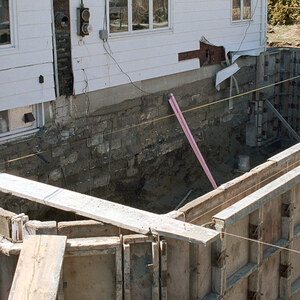We had the engineer on the job pay us a visit yesterday and one thing he noted was that on a load bearing partition wall that required doubling up on the 2 x 4’s half the studs were marked standard grade and the other half stud grade. He mentioned that the standard grade was better and stronger than the stud grade. I do all the material ordering and I call for 2 x 4 x 10 doug fir. I never specified standard or stud grade. Should I? Have any of you had experience with standard vs stud grade/
Thanks
Of all the things I’ve lost, I miss my mind the most


















Replies
According to the info I've been able to find, Stud is stronger than Standard in Fb, extreme fiber bending stress, 700 vs 575 PSI. That means that if they were used as joists, Stud would take more weight before breaking. Used as studs, this means that Stud would hold up better against heavy loads that bend the studs outward into an "S" curve between the blocking and plates. It would take more weight before breaking, but any time a column bows out, you're in way way deep doo doo. There's a vicious cycle of more deflection making the column ever weaker, so they fail quickly if they ever get started. Both grades are the same for modulus of elasticity, E, which is a measure of stiffness and the ability to not start bending in the first place.
Standard is better in Fc Par, compression parallel to the grain, 1400 vs. 850 PSI. This means that Standard is better for endwise crushing, like if you took a piece 2" long and crushed it in a vise. If your bearing wall is shearwalled with structural plywood to prevent the "S" curve deflection, this would seem to be a good thing. But as a practical matter, the studs bear on plates on both ends perpendicular to the grain. Whatever grade they are, if they're Doug Fir, they're only good for 650 PSI in Fc Perp. So the plates would fail first.
Stud is also better in tension, not that that happens much in framing except for things like collar ties or in trusses. If a storm or something were to put tension on your bearing wall studs, you've got much bigger problems, and the nails would pull out much easier than the wood would fail in tension.
Bottom line, your engineer saw it and didn't tell you to change it, so it's probably OK. And if it isn't OK, it's his responsibility.
Looking at earthquake and storm destruction, my general sense of it is that wood doesn't break all that much, most of the failure is nails pulling out of wood. So, I'm a big fan of Simpson hardware.
The following was supposed to be a table, but I couldn't get this site to work with the Courier font:
Lumber Grading marks for 2x Doug Fir:
Grade Fb Ft Fc Par E
Sel Str 1500 1000 1700 1.9
1 & Btr 1200 800 1550 1.8
1 1000 675 1500 1.7
Const 1000 650 1650 1.5
2 900 575 1350 1.6 *
Stud 700 450 850 1.4
Stand 575 375 1400 * 1.4
3 525 325 775 1.4
Util 275 175 900 * 1.3
Fb = Extreme fiber bending stress
Ft = Tension stress
Fc par = Compression parallel to grain
E = Modulus of Elasticity
Fv = Horizontal shear = 180 for all
Fc perp = Compression perpendicular to grain = 625 for all
-- J.S.
cyber.. johns got a lot of good points...
the only thing i would add is if you are the buyer, you should be specing what you want.. or at least asking for the difference in price for one grade over another .. also..
if you are in the NW.. doug fir may be cheap.. here we would pay a large premium for DF.. none of the yards stock it anymore... and the better ones always used to
Mike Smith Rhode Island : Design / Build / Repair / Restore
I am building in the Northeast , New York. I usually do spec what I want when I place an order, such as 3/4" CDX doug fir ply, not pine ply. I learn something new every day and I never noted the diference between stud and standard grade. I do always check that my studs are stamped d-fir, etc. I never checked the etc. part.
As far as the structural integrity, we are in aliitle bit of doo doo. The house has some deflection in short spans, up to 3/4" in 4' runs and that is why I called the meeting with the engineer. This 10,500 sq ft custom home has a lot of point loads and it was designed with off center bearing partion walls. 1st flr wall is 18" off of 2nd flr bearing wall and the engineer had us scab on 4' runs of rim board to compensate for the off center load. I had also suggested to him the idea of 3/4" ply under drywall to help strengthen the wall, and he will give me a report by Monday. This house has a few interesting conditions that I never encountered before, but the architect and engineer are really on the ball and on top of it.
Thanks,
Alex
of all the things i've lost, I miss my mind the most
interesting... 10,500 sf..... why don't i just shut up. ?...you need advice from me like yu need another hole in your head...
anyways.... those little lumber grading rule books make for interesting readingMike Smith Rhode Island : Design / Build / Repair / Restore
Curious, Mike...
What are you framing with? DF is still readily available 50 miles west of you.
exterior walls... hem-fir..... interior... KD -SPF
joists are usually hem-fir, #2 or better, sometimes KD-SPF if we're concerned about shrinkage
Mike Smith Rhode Island : Design / Build / Repair / Restore
Anyone looked at using finger-jointed studs? Straighter, just as strong, and as they become more readily available, should be less expensive.
Bob
still looking... haven't seen them here.. would really like them for remodelingMike Smith Rhode Island : Design / Build / Repair / Restore
I have an addition going up (plans just about finalized at arky's) that has steel in multiple locations from the foundation to the ridge. As such, KD-SPF has been called out for framing.
Normally it's doug fir, #2 or better.
Thanks for the feedback.